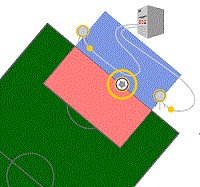On 5 July 2012, the International Football Association Board (IFAB) officially approved the use of goal line technology. The two systems approved in principle were involved in test phase 2: GoalRef and Hawk-Eye. In December 2012, FIFA announced it would introduce goal-line technology in a competitive match for the first time at the 2014 FIFA World Cup in Brazil. Starting in 2013, in the United States technology has been used in Major League Soccer. However MLS' Canadian teams do not use them in their home games due to the lack of funding. Goal-line technology was also implemented for the 2014 FIFA World Cup held in Brazil whereby the GoalControl system was installed in each of the 12 stadiums.
Background
The question of the inclusion of goal-line technology began to be raised in 2000 as a result of a penalty shootout during that year's Africa Cup of Nations final, when Victor Ikpeba's penalty for Nigeria against Cameroon was deemed by the referee not to have crossed the line after deflecting off the crossbar. To the contrary, television replays showed that it had.[5] Cameroon went on to win the shootout and thus the Trophy of African Unity.
Another incident occurred in August 2009 in a league match between Crystal Palace and Bristol City. Striker Freddie Sears knocked the ball over the line from close range, but the ball bounced off the stanchion below the net and then came back out. The goal was not given and Palace manager Neil Warnock was furious.[8][9] In March 2010, the International Football Association Board, which determines the laws of the game, voted 6-2 to permanently ditch the technology, with the Scotland and England football associations casting the dissenting votes. In a recent poll of 48 captains in the UEFA Europa League, 90% of respondents said that they wanted goal-line technology introduced.[10] Following several refereeing errors at the 2010 FIFA World Cup – including the disallowed goal in Germany's 4–1 victory over England, when Frank Lampard hit a shot from outside of the penalty box that bounced off the crossbar and over the line; the ball came back out and the goal was disallowed because the assistant referee did not call for a goal[11] – Blatter announced that FIFA would reopen the goal-line technology discussion.[12]
 Another instance of a controversial call was Chelsea’s 2–1 victory over Tottenham in 2011. Frank Lampard hit a shot just before halftime that slipped through the legs of Tottenham's goalkeeper Heurelho Gomes,
and almost crossed the line before being tipped back into play, however
the assistant called for a goal and Chelsea equalised before going on
to win.[13] Chelsea were credited with another goal that did not cross the line against the same opponents in the 2012 FA Cup semi-finals, leading again to calls for goal-line technology.[14]
Another instance of a controversial call was Chelsea’s 2–1 victory over Tottenham in 2011. Frank Lampard hit a shot just before halftime that slipped through the legs of Tottenham's goalkeeper Heurelho Gomes,
and almost crossed the line before being tipped back into play, however
the assistant called for a goal and Chelsea equalised before going on
to win.[13] Chelsea were credited with another goal that did not cross the line against the same opponents in the 2012 FA Cup semi-finals, leading again to calls for goal-line technology.[14]Before Euro 2012, UEFA president Michel Platini dismissed the need for goal-line technology, instead arguing for placing additional assistant referees behind the goal. However, in a Group D match with Ukraine losing 1-0 to England, the on-field Hungarian officials, Viktor Kassai and István Vad did not see Ukraine's Marko Dević's shot briefly cross the line before it was cleared by England's John Terry.[15]
